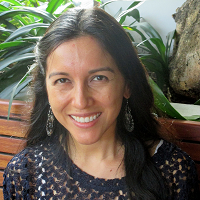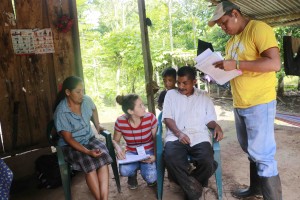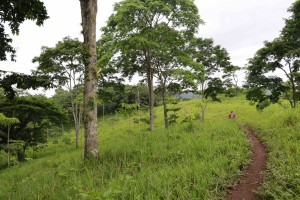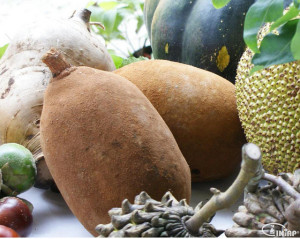
Tatiana Gumucio, Gender Postdoctoral Fellow, Decision and Policy Analysis research area, International Center for Tropical Agriculture (CIAT), works on a research project on gender sensitive climate-smart practices for coffee agroforestry in Nicaragua. The project under the CGIAR Research Program on Forests, Trees and Agroforestry, aims to find out more about the roles of women and men in decision making and how they value forests, trees and agroforestry. We asked her about the project’s goals, findings and her personal research story. You can find a project description at the bottom of this page.
Tatiana, what is this project about?
Societal and community gender roles influence the perceptions, values and uses that men and women associate with trees and non-timber forest products (NTFPs )and production systems like agroforestry.
To identify interventions for climate change mitigation and adaptation we have to look critically to the management of trees and tree resources for entry points. It is important to recognize that these same interventions constitute opportunities to reduce gender gaps in access to productive resources, the burden of labor, and decision-making power.
In this way, if we incorporate gender considerations into Climate Smart Agricultural (CSA) practices, we cannot only promote effective adoption of these practices. At the same time, this would also also contribute to more equitable development in rural territories.
Correspondingly, the project seeks to understand and analyze men’s and women’s values, perceptions, and roles in decision-making processes associated with trees, NTFPs and food crops in agroforestry systems to support the development of gender-sensitive CSA practices.
 What can this project achieve?
What can this project achieve?
As part of the research, we plan to share and discuss information on men’s and women’s roles in coffee agroforestry, and the implications of these roles for smallholders’ adaptive capacity and for food security, with coffee producer organizations. Due to gender-based constraints, women often benefit less than men from their participation in coffee value chains, and I am not only talking about income/money.
For this reason, knowledge-sharing with local coffee producer organizations will be important to develop business models that promote gender equitable control of productive forests, trees and agroforestry assets and resources.
How has this project emerged from previous research?
The CGIAR Research Program on Climate Change, Agriculture and Food Security (CCAFS) has been carrying out household gender surveys in Climate-Smart Villages in East Africa and Latin America. When preparing to implement the survey in the Tuma la Dalia site, which is within the Nicaragua-Honduras Sentinel Landscape, we saw the opportunity to use the survey to collect gender information related to land use and tree management among coffee agroforestry producers that largely make up the area.
Research carried out by the World Agroforestry Centre (ICRAF) and the University of Florida on cocoa agroforestry in Ecuador suggests that women value the non-monetary benefits of agroforestry more than men. Other ICRAF research in Vietnam suggests that women may often be more interested than men in agroforestry, although the former’s lack of access to productive resources can inhibit adoption.
At the same time, other research under the CGIAR Research Program on Forests, Trees and Agroforestry (FTA) and CCAFS shows that impacts of climate change can influence changes in decision-making roles within households, depending on which adaptation strategies these households adopt.
The survey with its emphasis on decision-making roles, and the additional proposed gender research on the site, allow us to continue with these lines of research to understand the gender dynamics surrounding agroforestry in a Latin American site that is vulnerable to climate change impacts, like Tuma la Dalia. It also allows us to develop climate change interventions with coffee agroforestry producers. Additionally, the research can build upon Sentinel Landscape data collected on land-use patterns.
You’ve worked with indigenous communities and sensitive issues. We would like to ask you about the complexities associated with conducting cross-cultural research, especially when studying complex and often context-specific gender norms. Have any such challenges emerged during this project? If so, how have you dealt with them?
 As this research is still in its initial stages, it is difficult to address local gender norms in depth. However, an underlying challenge in research that seeks to be gender transformative has to do with the ethics of breaking down repressive cultural norms.
As this research is still in its initial stages, it is difficult to address local gender norms in depth. However, an underlying challenge in research that seeks to be gender transformative has to do with the ethics of breaking down repressive cultural norms.
An indigenous woman can be exposed to dual discrimination both due to her gender and to her ethnicity. This discrimination effectively devalues her knowledge and skills in her own eyes as well as in the eyes of her family members.
Research methods that seek to document women’s views and knowledge can be met with a certain resistance, both by men and women, when it is not customary for women to engage with outside organizations like research institutions or play leading roles in public meetings spaces.
It is important to develop research methods that respect cultural norms, for example, by incorporating local input, working with local research assistants, and using translators.
Furthermore, our research can often highlight contradictions in men’s and women’s views, which can cause some controversy at the household and community level.
For instance, preliminary survey data in Nicaragua suggest that men tend to report that they are the primary decision-makers regarding land-use and agricultural activities, whereas women report that both they and their spouses are the primary decision-makers.
Participatory research approaches can be important in these cases – regularly soliciting feedback from local partners and community representatives – in order to incorporate local communities in the research cycle and ensure that research results do not come across as an affront but rather that they are shared and jointly discussed.
What is your background? How did you get to be where you are today?
I believe the multi-faceted nature of my background influences my research perspective. I am from the United States, but my family is originally from Bolivia. I am a cultural anthropologist, but I also have a Bachelor’s degree in International Business.
It was shortly after my undergraduate studies that I became incorporated into a development project with indigenous communities in lowland Bolivia. It was this particular experience that influenced my later studies in anthropology and in conservation and development.
My PhD research focused on how race, ethnicity and gender influence indigenous men’s and women’s participation in social movements in Bolivia. It took place in the context of the state’s proposal to build a major road through the communities’ indigenous reserve and national park (the Isiboro-Sécure Indigenous Territory and National Park, TIPNIS).
In this way, my research demonstrated how men’s and women’s biological and socio-cultural roles influence their priorities related to the environment and to development, and how these contribute to their indigenous political platform. This research has allowed me to appreciate that the goals and interests of target beneficiaries in development projects and policy initiatives are not homogeneous; a social group can be fragmented along gender, ethnic, and class lines, for example.
This also influences my interest in drawing attention to the need to base interventions and public policies in natural resource management on needs and interests at grassroots level.
It also motivates me to work in the gender and climate change group at CIAT, in Decision and Policy Analysis (DAPA). The perceptions and values that actors associate with forest, conservation, and development can vary according to their particular experience, and this influences how they respond to policies and interventions in sustainable development. This is a critical consideration for burgeoning initiatives for climate change adaptation and mitigation.
Given that this is the newsletter for the CGIAR research program on forests, trees and agroforestry, it is important to our readers to know: if you were a tree, which tree would you be, and why?

I would be the copoazu (Theobroma grandiflorum), particularly due to the memories I associate with it and its fruit. The indigenous communities with whom I worked in the Chaparé region of lowland Bolivia make a drink from the fruit’s pulp, and it can be quite refreshing on a warm day.
The fruit itself has a quite unassuming, plain brown thick skin; it’s once you get through the outer layer and work with the pulp that you get the exquisite flavor, which I think can be a good metaphor for social science research, particularly when it is focused on gender.
You have to “go deep,” beyond what is represented superficially at the surface, in order to fully appreciate how gender and other social markers influence the human experience.
Project title: Gender sensitive climate-smart practices for coffee agroforestry in Nicaragua
Objectives:
- Analyze the values and uses that men and women as primary decision-makers, of differing age groups, give to trees and tree/food crops within the agroforestry system.
- Understand the role of men and women of differing age groups in the decision-making process on the use and management of trees and food crops.
- Understand the perceptions of agroforestry as a land use for men and women as primary decision-makers of differing age groups.
- Develop gender-sensitive recommendations for climate-smart agriculture (CSA) practices related to agroforestry.
Methodology:
Household level socioeconomic data was collected within one of the Climate Change, Agriculture and Food Security (CCAFS) sites within the Nicaragua-Honduras Sentinel Landscape in Tuma La Dalia, Nicaragua in 2015. From 271 households, a total of 493 surveys were carried out with adult men and women who identified themselves as household members who were primarily responsible for agricultural decision-making. Respondents were largely smallholder coffee agroforestry producers. The survey collected household level data related to agricultural and agroforestry activities, and sex-disaggregated data about decision-making and adoption of CSA practices.
A proposed qualitative research component will complement the quantitative data and provide more in-depth information on perceptions and values. In recognition of the importance of other social markers on individuals’ engagement with natural resources and livelihood strategies, the research takes into account the intersection of age with gender. The qualitative methods to be used will include focus groups, semi-structured interviews, and transect walks.
Partners:
Nicaragua-Honduras Sentinel Landscape team, including CATIE and ICRAF scientists.
Local partner, Fundación para el Desarrollo Tecnológico Agropecuario y Forestal de Nicaragua (FUNICA)
Preliminary findings:
Data analysis of the gender survey is still in progress, but some initial findings include:
- Men and women may coincide in some ways on tree preferences. For example, when asked which tree was the most important for the household, men and women reported, in order of frequency, cedar (men 25% vs. women 19%), laurel (men 23% vs. women 14%) and coyote (men 8% vs. women 10%). These trees tend to be used for shade purposes in the agroforestry system.
- Women, especially those aged 31-45, may be more prone to adopt certain CSA practices than men, like living fences or wind breaks, reforestation, and those related to agroforestry.











